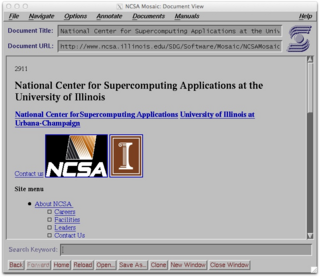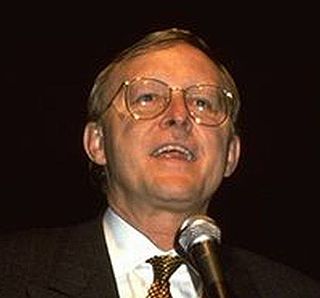Related Research Articles
Netscape Navigator is a discontinued proprietary web browser, and the original browser of the Netscape line, from versions 1 to 4.08, and 9.x. It was the flagship product of the Netscape Communications Corp and was the dominant web browser in terms of usage share in the 1990s, but by around 2003 its user base had all but disappeared. This was partly because the Netscape Corporation did not sustain Netscape Navigator's technical innovation in the late 1990s.
Netscape Communications Corporation was an American independent computer services company with headquarters in Mountain View, California, and then Dulles, Virginia. Its Netscape web browser was once dominant but lost to Internet Explorer and other competitors in the so-called first browser war, with its market share falling from more than 90 percent in the mid-1990s to less than one percent in 2006. An early Netscape employee Brendan Eich created the JavaScript programming language, the most widely used language for client-side scripting of web pages and a founding engineer of Netscape Lou Montulli created HTTP cookies. The company also developed SSL which was used for securing online communications before its successor TLS took over.

NCSA Mosaic is a discontinued web browser, and one of the first to be widely available. It was instrumental in popularizing the World Wide Web and the general Internet by integrating multimedia such as text and graphics. It was named for its support of multiple Internet protocols, such as Hypertext Transfer Protocol, File Transfer Protocol, Network News Transfer Protocol, and Gopher. Its intuitive interface, reliability, personal computer support, and simple installation all contributed to its popularity within the web. Mosaic is the first browser to display images inline with text instead of in a separate window. It is often described as the first graphical web browser, though it was preceded by WorldWideWeb, the lesser-known Erwise, and ViolaWWW.

James Henry Clark is an American entrepreneur and computer scientist. He founded several notable Silicon Valley technology companies, including Silicon Graphics, Netscape, myCFO, and Healtheon. His research work in computer graphics led to the development of systems for the fast rendering of three-dimensional computer images.

Ramanathan V. Guha is the creator of widely used web standards such as RSS, RDF and Schema.org. He is also responsible for products such as Google Custom Search. He was a co-founder of Epinions and Alpiri. He currently works at Google as a Google Fellow.

Marc Lowell Andreessen is an American entrepreneur, venture capital investor, and software engineer. He is the co-author of Mosaic, the first widely used web browser with a graphical user interface; co-founder of Netscape; and co-founder and general partner of Silicon Valley venture capital firm Andreessen Horowitz. He co-founded and later sold the software company Opsware to Hewlett-Packard. Andreessen is also a co-founder of Ning, a company that provides a platform for social networking websites. He sits on the board of directors of Meta Platforms. Andreessen was one of six inductees in the World Wide Web Hall of Fame announced at the First International Conference on the World-Wide Web in 1994. As of February 2023, his net-worth is estimated at $1.7 billion by Forbes. In March 2022 he was appointed to the Homeland Security Advisory Council by Secretary of Homeland Security Alejandro Mayorkas
Spyglass, Inc. was an Internet software company. It was founded in 1990, in Champaign, Illinois, as an offshoot of the University of Illinois at Urbana–Champaign, and later moved to Naperville, Illinois. Spyglass was created to commercialize and support technologies from the National Center for Supercomputing Applications (NCSA). It focused on data visualization tools, such as graphing packages and 3D rendering engines.

Mozilla was the mascot of Netscape Communications Corporation and subsequently the Mozilla Foundation. Its appearance has varied and the mascot has been retired from active use.

Netscape 7 is a discontinued Internet suite developed by Netscape Communications Corporation, and was the seventh major release of the Netscape series of browsers. It is the successor of Netscape 6, and was developed in-house by AOL. It was released on August 29, 2002 and is based on Mozilla Application Suite 1.0.

Winifred Mitchell Baker is the Executive Chairwoman and CEO of the Mozilla Foundation and of Mozilla Corporation, a subsidiary of the Mozilla Foundation that coordinates development of the open source Mozilla Internet applications, including the Mozilla Firefox web browser.
The history of the Mozilla Application Suite began with the release of the source code of the Netscape suite as an open source project. Going through years of hard work, Mozilla 1.0 was eventually released on June 5, 2002. Its backend code base, most notably the Gecko layout engine, has become the foundation of a number of applications based on Mozilla, including the Mozilla Foundation's flagship product Mozilla Firefox and Mozilla Thunderbird. While the suite is no longer a formal Mozilla product, its development and maintenance is continued as the SeaMonkey community project.

The Mozilla Application Suite is a discontinued cross-platform integrated Internet suite. Its development was initiated by Netscape Communications Corporation, before their acquisition by AOL. It was based on the source code of Netscape Communicator. The development was spearheaded by the Mozilla Organization from 1998 to 2003, and by the Mozilla Foundation from 2003 to 2006.
Tim Howes is a software engineer, entrepreneur and author. He is the co-creator of the Lightweight Directory Access Protocol (LDAP), the Internet standard for accessing directory servers. He co-founded enterprise software company Opsware, internet browser company Rockmelt, and children's education company, Know Yourself. He has co-authored two books, several Internet RFCs, and holds several patents.

The World Wide Web is a global information medium which users can access via computers connected to the Internet. The term is often mistakenly used as a synonym for the Internet, but the Web is a service that operates over the Internet, just as email and Usenet do. The history of the Internet and the history of hypertext date back significantly further than that of the World Wide Web.

The Netscape web browser is the general name for a series of web browsers formerly produced by Netscape Communications Corporation, which eventually became a subsidiary of AOL. The original browser was once the dominant browser in terms of usage share, but as a result of the first browser war, it lost virtually all of its share to Internet Explorer due to Microsoft's anti-competitive bundling of Internet Explorer with Windows.
A web browser is a software application for retrieving, presenting and traversing information resources on the World Wide Web. It further provides for the capture or input of information which may be returned to the presenting system, then stored or processed as necessary. The method of accessing a particular page or content is achieved by entering its address, known as a Uniform Resource Identifier or URI. This may be a web page, image, video, or other piece of content. Hyperlinks present in resources enable users easily to navigate their browsers to related resources. A web browser can also be defined as an application software or program designed to enable users to access, retrieve and view documents and other resources on the Internet.
Michael J. Homer was an American electronics and computer industry executive who played major roles in the development of the personal computer, mobile devices and the Internet.
An Internet operating system, or Internet OS, is any type of operating system designed to run all of its applications and services through an Internet client, generally a web browser. The advantages of such an OS would be that it would run on a thin client, allowing cheaper, more easily manageable computer systems; it would require all applications to be designed on cross-platform, open standards; and would not tie a user's applications, documents, and preferences to a single computer, but rather place them in the Internet cloud. The Internet OS has also been promoted as the perfect type of platform for software as a service.

Laura Arrillaga-Andreessen is an American philanthropist, educator and author.
References
- ↑ Kim, Eugene Eric (1999-12-01). "Internet Time as History". Dr. Dobb's Journal. Archived from the original on 2008-09-30. Retrieved 2007-02-03.
- ↑ "Netscape's Marc Andreessen". Time Magazine. 1996-02-19. Archived from the original on February 17, 2005. Retrieved 2007-02-03.
- ↑ "Rosanne M. Siino, Ph.D. Home Page". official web page. Retrieved 2008-04-27.
- ↑ "Organizations, Technology and Entrepreneurship" . Retrieved 2009-05-07.
- Wolfe, Gary. "The (Second Phase of the) Revolution Has Begun: Don't look now, but Prodigy, AOL, and CompuServe are all suddenly obsolete – and Mosaic is well on its way to becoming the world's standard interface". Wired. Wired Magazine. Retrieved February 3, 2007.
- Clark, Jim (1999). Netscape Time: The Making of the Billion-Dollar Start-Up that Took On Microsoft. St. Martin's Press. ISBN 0-312-19934-1.
- Swisher, Kara (June 1999). AOL.com. Three Rivers Press. ISBN 0-8129-3191-2.